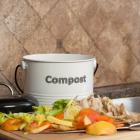Surprisingly Big Feet: Why your pet’s carbon footprint matters and what you can do to reduce it
Submitted by Jessica Gordon on | Updated Sat, 17/09/2016 - 23:49

For so many people our pets are a part of the family. We care for them, worry about them, watch them grow and enjoy their personalities, and sadly, mourn them when we have to say goodbye. They are very much a part of our lives but it’s easy to over look the impact the often the hairiest member of the family can have, not just in terms of our carbon footprint, but also in terms of our perspective. Despite all we do for them, oddly sometimes we seem to forget our pets when it comes to making sustainable choices. But once we’ve learned what their impact is, what are we supposed to do about it? Should you be switching Mittens to vegan cat food?
Looking at attitudes towards pet ownership researchers at Murdoch University in Australia conducted a study of both cat owners and non-cat owners from various countries around the world. They found a range of attitudes towards a cat’s interaction with local wildlife but in general, according to ABC.net in Australia, to change people’s attitudes they had to stress the welfare of the cat as opposed to that of the local wildlife. They found, in Australia, that people were most likely to be concerned about the impact their out door cat could have. This isn’t all that surprising considering that Australia has some very strict biosecurity laws. They made headlines last year when Johnny Depp and his dogs learned this the hard way. Australian authorities threatened to euthanize the dogs if they were not removed from the country, as they had not passed through Australia’s quarantine.
This study speaks to our attitude about our pets. We want the best for them and we want to take care of them but we don’t necessarily think about how we need to take responsibility for all their actions even the ones that they have no control over, like the spread of disease. We take the responsibility to make sure our dog doesn’t go to the bathroom on someone’s floor by taking them outside to do their business but we don’t think twice about using plastic bag after plastic bag to clean up their poo.
Speaking of Johnny Depp and his dogs, Pistol and Boo, if we dig a little deeper we learn that rabies, doesn’t exist in Australia and their strict biosecurity laws and quarantine procedures are fighting to keep it that way. Ultimately, the dogs leaving the country was the best scenario for all, Johnny Depp, his dogs and Australia’s wildlife. The story has a happy ending; the dogs made it safely home to the US on a private jet. However it’s hard not to speculate as to the kind of carbon footprint these two jet-setting pooches must have considering how far they travelled and how much of it could have been avoided if they had stayed home.
So what’s their impact?
In terms of C02 emissions, for anyone who has every punched in their data on a carbon footprint calculator you will notice how much it jumps up if you happened to have travelled by plane even once in the last year. Luckily, unlike Pistol and Boo, most pets don’t spend too much time travelling by air. They do however have an impact and a carbon footprint. An article in the Globe and Mail in 2013 stated that Canadian pets alone are responsible for 650,000 tonnes of waste per year.
I decided to figure out the carbon footprint for my friend Oppie, the dachshund pictured above. There are plenty of carbon calculators out there and while I chose one of the more general ones, the Guardian has a list here with more detailed options. Obviously this was not highly accurate as Oppie is a dog, but there are a few things to keep in mind; when he’s at home and it is warm out a fan will be left running, or the A/C when it get’s hotter. When it is cold the heat isn’t turned down as much as if no one were home. The carbon footprint calculator I chose asked about clothing purchasing habits, while Oppie doesn’t get much say in his style, he is very low to the ground and he does wear a jacket and disposable rubber booties in the winter, though one set can usually last him the season (unless it get’s lost in the snow). Also Oppie doesn’t do much driving because his owners don’t own a car and mostly travels by foot (or human when he gets tired). Lastly he eats a high protein dried dog food diet made with chicken and while Oppie is not on a vegan or vegetarian dog food diet he also enjoys the occasional veggie that happens to fall on the floor. Even without any driving (or flying) and the fact he lives in an apartment in Toronto ON, he has a carbon footprint of (very) roughly 3.63 metric tons of CO2e for the year. According to the World Bank the metric ton per capita of CO2 emissions for Canada is 14.1 as of 2015 and the target we should all be aiming for is 2 metric tons of CO2e according to the carbon foot print calculator I used. It’s Oppie’s diet that has him missing the target.
In 2009 Robert and Brenda Vale published their book “Time to Eat the Dog?” in which they propose some controversial ideas on sustainable pet ownership such as raising edible pets (and not kind that comes out of a seed packet). They also looked at our pets’ footprints in terms of the land used for the production of their food. Breaking everything down in terms of how much protein and carbohydrates a low meat content dried food contains and then how much land is used in the production of those foods (meat and cereals). Taking into account how much the average cat eats per day (estimated at 70g) and multiplying that by a year, the average well-fed domestic cat requires about 1500 m² or 0.15 hectares (ha) of land. It starts to add up when you look at their estimated combined footprint for the cat population of the US. At the time the book was published it was 15,286,000 ha or 152,860 km². (Vale and Vale, 2009, p. 231) Averaging out small, medium and large sized dogs in the US to determine the amount of land and required for dried dog food, they found that dogs require 2700 m² of land individually and 164,916 km² per year for the whole population (Vale and Vale, 2009, p. 237). That’s only about 100,000 km² less then the size of New Zealand, which is where the Vales are from. (Vale and Vale, 2009, p. 238)
The Vales calculations aren’t perfect, they don’t take into consideration the fact that the animal products our pets eat are often the parts we don’t want to eat ourselves but they do make it very clear that our pets have an impact in terms of the resources they require for their food.
They look at the different impacts that different diets have, comparing a dried dog food diet with that of a dog fed a typical human diet (in this case that of the typical resident of Cardiff, Wales). If we go back to the US the difference is striking, with the total dog population requiring 29,318,400 ha (293,184 km²) if fed a human diet vs. the 16,491,600 ha (164,916 km²) for dried food from before. (Vale and Vale, 2009, p. 237)
For the population of American cats they looked at tinned food, comparing low meat content and fish. They found low meat tinned food required 9,935,990 ha (approximately 99,360 km²) and tinned fish required 41,272,200 ha (412,722 km²). They also compared high meat content vs. low meat content in their dried cats foods and found that 15,286,000 ha (152,860 km²) is required for low meat content and 64,201,200 ha (642,012 km²) is required for high meat content. That’s officially bigger then New Zealand.
What do we do about our pets’ footprint?
According to calculations the average dog has an impact of about 2.4 tonnes of CO2e, which is lower then Oppie’s 3.63 tonnes, so Oppie clearly has some adjustments to make but so could many or our pets. Oppie is already on a weight loss diet and according to that Globe and Mail article this is a step in the right direction. It is also a necessary step for all our overweight furry friends because there are a lot of them as we as owners tend to overfeed. (Mitchell, 2013) Talking to your pet’s vet is good way to find out if your feeding you pet too much and if they can afford to shed a few, but not all our pets are overweight.
It is clear form the Vales’ calculations that generally it is the high meat factor in our pets’ foods that cause the impact. While there are those out there that have fed their pets vegetarian dog food or vegan cat food it can be very tricky and is not recommended for the faint of heart. That being said it is much easier for dogs to go vegetarian or vegan then cats, as dogs are are omnivores and cats are carnivores. If you do decide to try your pet on vegan or vegetarian dog or cat food please consult your vet to make sure they are getting all the nutrients they need in a form that they can digest. Switching to vegetarian or vegan cat or dog food is a big step that many humans have not taken in their own diets and there are other options to help reduce our pets’ food footprint.
The best way to control the kind of animal protein in your pet food is to make the food yourself. Choosing locally produced ingredients and avoiding a lot red meat in their diets (like ours) can help to reduce C02 emissions. Chicken has a significantly lower impact then beef. The GHG emissions figures from 2001 show that beef was responsible for 119 kg CO2e/kg protein in Canada where as broiler chickens (the ones typically bred to eat) were responsible for 10.6 kg CO2e/kg protein. (Dyer et. al. 2010b, p.623)
Pet home cooking is also a great way to cut down on cereals and replace them with veggies as the production of cereals can result in more GHG emissions then that of veggies. This is another area to be careful of nutrients and digestion, especially if you’ve decided your pet could make the switch to vegan or vegetarian cat food or dog food. In 2006, measuring in terms of mg of CO2e per mg of dried matter, most of the cereals produced (including grain corn, mixed grains, oats, spring wheat, winter wheat, and fall rye) were more carbon intensive then the forages (alfalfa, tame hay and corn sileage), and root crops (potatoes and sugar beets) and cereals were about the same for pulses (chick peas, dry peas, beans and lentils). (Dyer et. al. 2010a) That being said, in terms of total production of particular crops in 2006, cereals (including the less carbon intensive barley and durum wheat) were responsible for 19.1 teragram (1 teragram is equal to 1 billion kgs) of CO2e where as the total for forages, pulses, and root crops was 8 teragram (tg) of CO2e combined. (Dyer et. al. 2010a)
Here are a few resources for getting started with your pet’s home cooking:
Cats:
http://www.care2.com/greenliving/gourmet-kitty-homemade-cat-food.html
Dogs:
Not all of us have the time to cook well-balanced homemade meals for ourselves every night let alone our pets. And having your dog or cat on dried food diet does help to reduce their impact. Another good option is paying attention to the ingredients on your pet’s food to determine what kind of meat protein; cereals and veggies are in it. Here is a list of pet food producers that pay attention not just to the quality of the ingredients but to their supply chain as well and some of them are produced locally in Canada.
A few other key things to remember:
-
Use biodegradable plastic bags for their waste.
-
Use sustainably produced (not clay from strip-mining) and eco-friendly kitty litter.
-
Be mindful of how they interact with local wildlife and where you let them roam free.
-
Make sure your pet’s vaccinations are up to date and leave them at home on your next visit to Australia.
We are responsible for the world they live in and yet they make our lives so much brighter for being a part of it. Ultimately it comes down to us changing our habits and by extension changing theirs. We need to a build a sustainable future that has room for them too and that means changing the way we look at their role in our shared world.
Sources:
Carbon Calculators. Retrieved from http://www.carbonfootprint.com/calculator1.html
Dyer, J., Verge, X., Desjardins, R., Worth, D., & McConkey, B. (2010a, March 31). The impact of increased biodiesel production on the greenhouse gas emissions from field crops in Canada. Energy for Sustainable Development, 14(2), 73-82. Retrieved from http://www.sciencedirect.com/science/article/pii/S097308261000013X
DYER, J. A., VERGÉ, X., DESJARDINS, R., & Worth, D. (2010b, July). The Protein-based GHG Emission Intensity for Livestock Products in Canada. Journal of Sustainable Agriculture, 34, 618-629. doi:10.1080/10440046.2010.493376
Gartry, L. (2016, May 18). Cat owners more concerned about pet welfare than risks to wildlife, study finds. ABC.net Australia. Retrieved from http://www.abc.net.au/news/2016-05-18/cat-owners-more-concerned-about-pet-welfare-wildlife-risk/7425698
Hawn, R. (n.d.). Should Your Pet Go on a Vegetarian Diet? Retrieved from http://pets.webmd.com/features/vegetarian-diet-dogs-cats
Lavi, S. (2016, May 4). The Eco-Friendly Scoop on Doggy Bags: Reduce Your Dog’s Carbon Pawprint. The Eco Guide. Retrieved from http://theecoguide.org/eco-friendly-scoop-doggy-bags-reduce-your-dogs-carbon-pawprint
Mitchell, A. (2013, August 2). How feeding and caring for 800 million pets hurts Mother Nature. The Globe and Mail. Retrieved from http://www.theglobeandmail.com/life/how-feeding-and-caring-for-800-million-pets-hurts-mother-nature/article13584868/?page=all
Taylor, A. (2015, May 14). The biosecurity logic behind Australia’s threat to kill Johnny Depp’s dogs. The Washington Post. Retrieved from https://www.washingtonpost.com/news/worldviews/wp/2015/05/14/the-biosecurity-logic-behind-australias-threat-to-kill-johnny-depps-dogs/
Vale, B., & Vale, R. (2009). Time to eat the dog?: The real guide to sustainable living. London: Thames & Hudson.
Ward, M. (2015, June 22). Johnny Depp's wife Amber Heard accuses Barnaby Joyce of fame seeking over dogs. The Sydney Morning Herald. Retrieved from http://www.smh.com.au/lifestyle/celebrity/johnny-depp-and-amber-heard-will-avoid-down-under-from-now-on-20150622-ghueuq.html
What Are the Most Ecofriendly Cat Litter Products on the Market? (2012, September 12). Retrieved from http://www.scientificamerican.com/article/green-friendly-cat-litter-options/
The World Bank. (2016). Canada. Retrieved from http://data.worldbank.org/country/canada
You will save the Earth by sharing and/or tweeting (corny right?)





